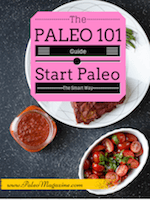Why Aren’t Potatoes Paleo? 5 Reasons To Reconsider (+ Blood Sugar Cheatsheet)
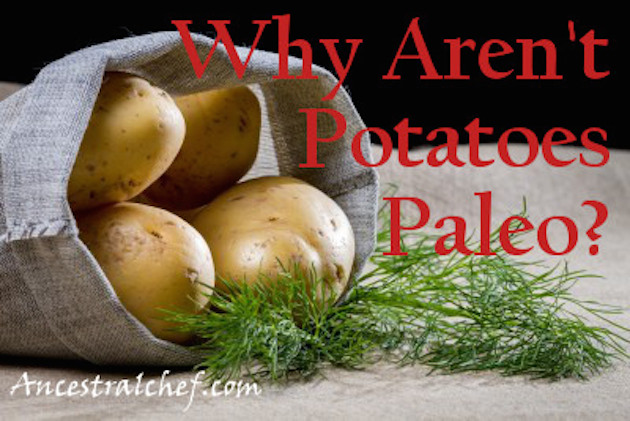
Why are Potatoes Not Paleo? But yet, Sweet Potatoes are?
Think it’s because Potatoes aren’t as nutritious as Sweet Potatoes? Well, then you’re in for a shock!
Think it’s because Potatoes are more toxic than Sweet Potatoes? Well, again you’re in for a shock!
So what’s the real reason for this, and is it even a good reason? Well, I think I’ve posed a lot of questions, and this article is going to provide some answers.
Nutrition: Potatoes v. Sweet Potatoes
For the nutritional aspect, I compared nutritional data for 100g of boiled potato flesh (no skin) and for 100g of boiled sweet potato flesh (no skin), using the numbers from NutritionData.self.com.
1. Proteins and Amino Acids
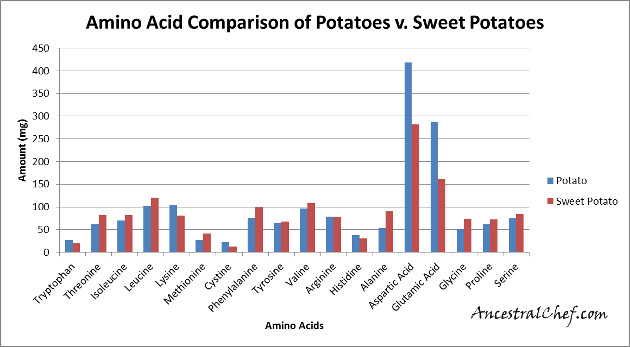
The blue is potatoes, and the red is sweet potatoes. As you can see from the chart, the the amino acid profile of potatoes and sweet potatoes are actually very similar! In fact, potatoes have higher amounts of 7 out of the 18 amino acids profiled here: tryptophan, lysine, cystine, arginine, histidine, aspartic acid, and glutamic acid.
And for the amino acids that sweet potatoes are higher on, potatoes are not much lower. Definitely not low enough for potatoes to be considered less nutritious than sweet potatoes.
2. Vitamins
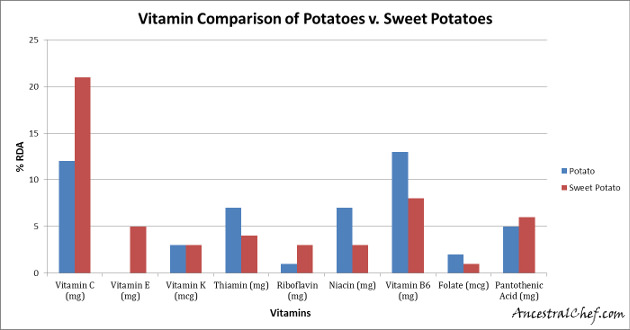
According to the chart above, potatoes have higher Recommended Dietary Allowances (“RDA”) percentages for 4 of the 10 vitamins featured here and hav the same RDA percentages for 2 of the vitamins (vitamin K and vitamin B12).
If you are super observant, you will notice that I’ve left out three vitamins from the chart (A, D, and B12). The reason that vitamins D and B12 aren’t included is because neither potatoes nor sweet potatoes have any significant amounts of those vitamins.
Vitamin A isn’t on the chart because it would go right off the chart! Sweet potatoes (the yellow and orange types at least) have huge amounts of vitamin A (hence their yellow/orange color, like carrots). Potatoes, on the other hand, have zero vitamin A.
Incidentally, the reason why neither potatoes nor sweet potatoes have any vitamin B12 (which is a seriously critical vitamin) is because hardly any plants have it, whereas it’s present in many animal products.
So, if you’re in serious need of vitamin A, then yes, sweet potatoes would be a better choice. But other than that, there’s hardly any difference in their vitamin profiles.
3. Minerals
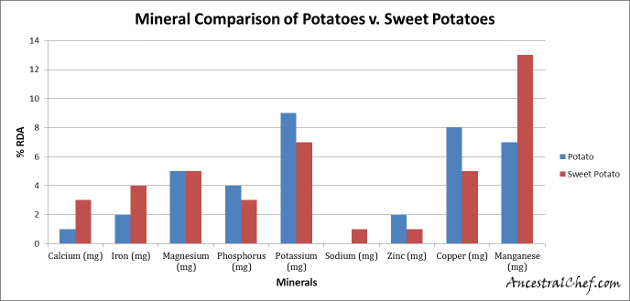
Potatoes have higher mineral RDA percentages for 4 of the 9 minerals profiled above, and have the same percentage for one of the minerals (magnesium). So again, there’s nothing to suggest that sweet potatoes have a significantly better mineral profile!
4. All Other Nutrient Information (Calories, Carbohydrates, Fats)
Let’s go through the boring ones first:
As you can imagine, both potatoes and sweet potatoes are pretty similar in terms of calories (86 calories for 100g of boiled potato flesh and 76 calories for 100g of boiled sweet potato flesh). And they both have pretty much zero fat!
Now comes the more interesting nutrient…carbohydrates. Although they both have similar total amounts of carbs (20g for potatoes and 17.7g for sweet potatoes), they differ as to what types of carbs they contain.
While potatoes contain a lot of starch, sweet potatoes are high in sugars (particularly, sucrose and maltose). I’ll discuss the glycemic index of each tuber below, but just in terms of the amount of carbohydrates, there’s not much difference.
5. Conclusion for Nutrient Profiles
There’s really not a huge difference in nutrients between potatoes and sweet potatoes. The main difference is that sweet potatoes contain huge amounts of vitamin A.
So what is the Reason for Why Paleo supports Sweet Potatoes but not Potatoes?
Loren Cordain (often considered the founder of Paleo) argues in both his books that potatoes should not be part of the Paleo Diet. The rationale for this stems from the following 3 reasons: (1) potatoes have one of the highest glycemic indexes, (2) most potatoes are consumed in highly processed forms, and (3) potatoes contain a toxin called saponin (also known as glycoalkaloids).
These are actually 3 good points, but it doesn’t necessarily mean that potatoes should be written off altogether!
1. Potatoes have high GIs
There are varying data sets for glycemic indices (“GIs”) just like there is for nutritional values, but the fact is that potatoes definitely do have higher GIs. However, just how important is the GI difference?
On average, white boiled potatoes have a GI of 82 where as sweet potatoes have 70. Baking can increase GI and the skin on both increases GI (according to data on www.glycemicindex.com). Different varieties of potatoes and sweet potatoes will have different GIs.
However, if we look at the glycemic load (“GL”) instead (which is often considered the better predictor of blood glucose values), then there’s actually practically no difference! Potatoes have an average of 21 and sweet potatoes have an average of 22.
Ultimately, if effect on blood sugar is something you care about (which many of us probably should worry about), then neither potatoes nor sweet potatoes are something you should be eating.
2. Potatoes are consumed in highly processed forms
Also, while potatoes can be consumed highly processed, so can a lot of foods permitted on the Paleo Diet (think various sweet potato chips and MSG-filled beef jerky). Clearly processed junk is not good for you, but I don’t find that a compelling reason to ban all potatoes!
3. Potatoes contain saponins
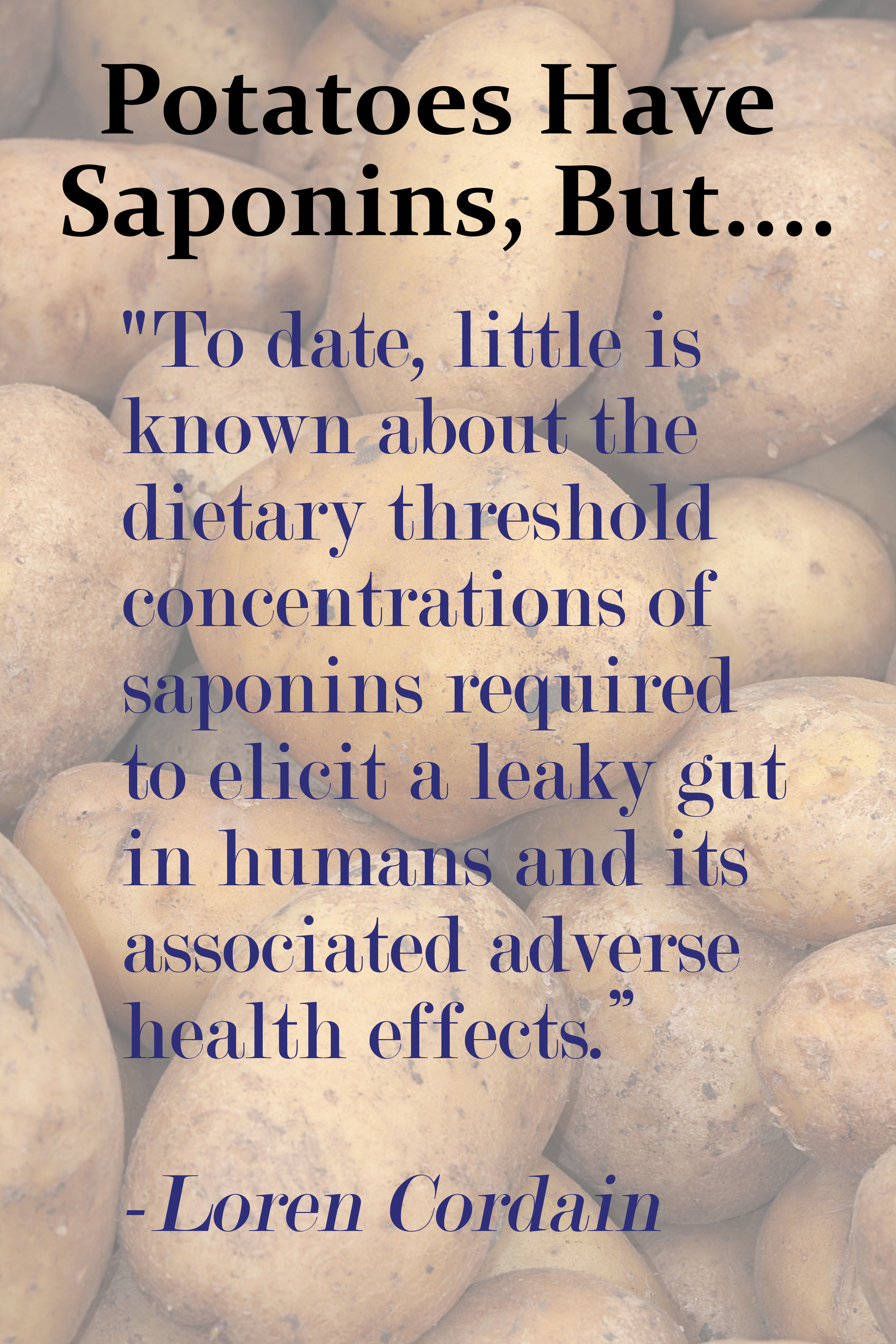
Saponins are toxins present in various plants (including spinach, oats, chick peas, beans, asparagus tea, onions, yams, garlic, tomatoes, and peppers) as well as potatoes, but the aren’t present in sweet potatoes.
In plants, they act as a protection mechanism for the plant, but when we ingest saponins, they could potentially cause leaky gut problems, although even Loren Cordain clearly states that “[t]o date, little is known about the dietary threshold concentrations of saponins required to elicit a leaky gut in humans and its associated adverse health effects.”
So exactly how much saponins do potatoes have and how to do they compare to other vegetables?
Most of the saponins in potatoes are concentrated in the skin, so if we just don’t eat those, then boiled potatoes have around 27-42 mg of saponins per kg (see Stephan Guyenet’s graph showing the differences in saponin content between different potatoes). Tomatoes also contain saponins (just different types), and ketchup can have 8.6 mg/kg while small immature unripe green tomatoes have around 548 mg/kg (numbers cited by Loren Cordain). Then there are really high saponin containing plants, like asparagus. Data suggests that there would be around 15000 mg/kg (although most of this is concentrated in the stem)!! Spinach root contains even higher amounts of saponins (although luckily if you just eat spinach leaves, you won’t be ingesting much).
So, it’s really unclear right now just how problematic the saponins in potatoes are, but if you’re looking to avoid saponins altogether, then there’s a lot more you ought to be worried about than just potatoes! For most of us, eating peeled potatoes should be fine!
Conclusion
All the data seems to suggest that eating potatoes (especially baked or boiled and without the skin) is totally fine! I’m not recommending potato chips or French fries here, unless you make them yourself as a treat with coconut oil. But, there’s really no real nutritional difference between potatoes and sweet potatoes. And if you’re concerned with autoimmune and gut permeability issues, then you would be a hypocrite to just not eat potatoes but then keep eating all those other vegetables!
It’s advised on the Autoimmune Protocol (AIP) to avoid all nightshades (there’s a comprehensive list of them here) and then add them back in gradually to test how you react to them. If you have an autoimmune condition, then you might want to try avoiding all nightshades (including potatoes, tomatoes, and peppers) initially. For more information about the Autoimmune Protocol, read this article.
A quick note about The Perfect Health Diet
If you’re not familiar with Paul Jaminet and Shou-Ching Jaminet, then you should definitely read their fantastic book, Perfect Health Diet. It goes into a lot of science about ancestral diets and recommends that white rice and white potatoes are generally “safe starches” to eat. Their book was one of the things that prompted me to investigate white potatoes!
Images: Copyright (c) 123RF Stock Photos SXC.

